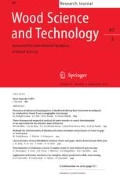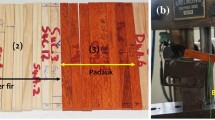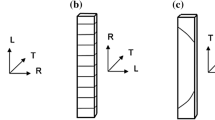Summary
This paper describes the study of possible interactions between the viscoelastic and mechano-sorptive creep inPinus sylvestris. When two periods of constant-moisture creep were separated by a period of mechano-sorptive creep, the expected creep rate during the second viscoelastic period was decreased. A similar effect was observed during creep recovery. These results were taken to indicate an interaction between the two types of creep, although not necessarily a common mechanism. During recovery with uniform moisture cycling, the effects of one extra low and one extra high humidity were observed. The low humidity showed no significant effect, but the high humidity significantly increased the recovery. This was attributed to a parallel effect to that of creep: namely, the creep acceleration that occurs at a higher moisture level than has previously been reached during the test.
Similar content being viewed by others
References
Armstrong L, Kingston R (1960) The effect of moisture changes on creep in wood. Nature 185:862–863
Armstrong L, Kingston R (1962) The effect of moisture-content changes on the deformation of wood under stress. Austral. J. Appl. Sci. 13: 257–276
Boyd J (1982) in “New Perspectives in Wood Anatomy” edited by P. Baas (Nijhoff-Junk, The Hague) pp. 171–222
Grossman P (1976) Requirements for a model that exhibits mechano-sorptive behaviour. Wood Sci. Technol. 10: 163–168
Hanhijärvi A (1995) Modelling of creep deformation mechanisms in wood. Espoo: Technical Research Centre of Finland (VTT). VTT Publications 231. 143 p. + app. 3 p
Hunt D (1986) The mechano-sorptive creep susceptibility of two softwoods and its relation to some other materials properties. J. Materials Sci. 21: 2088–2096
Hunt D (1997) Dimensional changes and creep of spruce, and consequent model requirements. Wood Sci. Technol. 11: 31: 3–16
Hunt D, Darlington M (1978) Accurate measurement of creep of nylon-6,6 at constant temperature and humidity. Polymer 19: 977–983
Hunt D, Gril J (1996) Evidence of a physical ageing phenomenon in wood. J. Materials Sci. Letters 15: 80–82
Ranta-Maunus A (1975) The viscoelasticity of wood at varying moisture content. Wood Sci. Technol. 9: 189–205
Ranta-Maunus A (1976) A study of the creep of plywood. Espoo: Technical Research Centre of Finland (VTT). Structural mechanics laboratory, report 5. 85 p. + app. 7 p
Author information
Authors and Affiliations
Rights and permissions
About this article
Cite this article
Hanhijärvi, A., Hunt, D. Experimental indication of interaction between viscoelastic and mechano-sorptive creep. Wood Sci.Technol. 32, 57–70 (1998). https://doi.org/10.1007/BF00702560
Received:
Issue Date:
DOI: https://doi.org/10.1007/BF00702560




